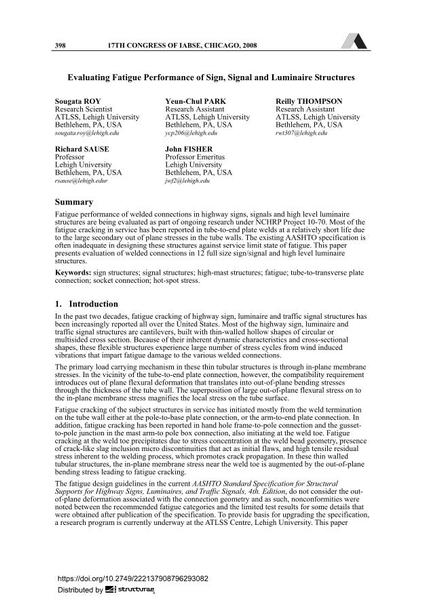Evaluating Fatigue Performance of Sign, Signal and Luminaire Structures

|
|
|||||||||||
Bibliographic Details
| Author(s): |
Sougata Roy
Yeun-Chul Park Reilly Thompson Richard Sause John Fisher |
||||
|---|---|---|---|---|---|
| Medium: | conference paper | ||||
| Language(s): | English | ||||
| Conference: | 17th IABSE Congress: Creating and Renewing Urban Structures – Tall Buildings, Bridges and Infrastructure, Chicago, USA, 17-19 September 2008 | ||||
| Published in: | IABSE Congress Chicago 2008 | ||||
|
|||||
| Page(s): | 398-399 | ||||
| Total no. of pages: | 8 | ||||
| Year: | 2008 | ||||
| DOI: | 10.2749/222137908796293082 | ||||
| Abstract: |
Fatigue performance of welded connections in highway signs, signals and high level luminaire structures are being evaluated as part of ongoing research under NCHRP Project 10-70. Fatigue failure of these structures is increasingly being reported in the United States due to wind induced oscillations, which has serious economic impact on the limited infrastructure resources from safety and maintenance points of view. Most of the fatigue cracking in service has been reported in tube- to-end plate welds at a relatively short life due to the large secondary out of plane stresses developed in the thin walled tubes from incompatibility in deformation, which is precipitated by the flexibility of the end plate. The existing AASHTO specification, which is based on nominal stress and derived from the guidelines that are valid for predominantly in-plane stresses or membrane stresses, is often inadequate in designing these structures against service limit state of fatigue. This paper presents experimental evaluation of welded connections in 12 full size sign/signal and high level luminaire structures, and compares the test results with predicted fatigue lives obtained by a hot-spot stress based analytical protocol. |
||||
| Keywords: |
fatigue hot-spot stress sign structures signal structures high-mast structures tube-to-transverse plate connection socket connection
|
||||
